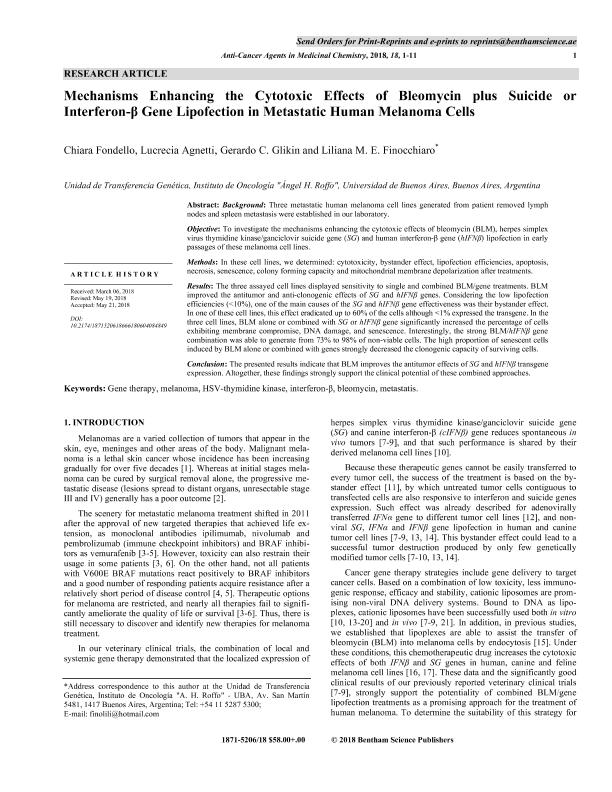Mostrar el registro sencillo del ítem
dc.contributor.author
Fondello, Chiara

dc.contributor.author
Agnetti, Lucrecia

dc.contributor.author
Glikin, Gerardo Claudio

dc.contributor.author
Finocchiaro, Liliana Maria Elena

dc.date.available
2020-03-13T13:56:53Z
dc.date.issued
2018-05
dc.identifier.citation
Fondello, Chiara; Agnetti, Lucrecia; Glikin, Gerardo Claudio; Finocchiaro, Liliana Maria Elena; Mechanisms enhancing the cytotoxic effects of bleomycin plus suicide or interferon-β gene lipofection in metastatic human melanoma cells; Bentham Science Publishers; Anti-cancer Agents In Medicinal Chemistry; 18; 9; 5-2018; 1338-1348
dc.identifier.issn
1871-5206
dc.identifier.uri
http://hdl.handle.net/11336/99441
dc.description.abstract
Background: Three metastatic human melanoma cell lines generated from patient removed lymph nodes and spleen metastasis were established in our laboratory. Objective: To investigate the mechanisms enhancing the cytotoxic effects of Bleomycin (BLM), herpes simplex virus thymidine kinase/ganciclovir Suicide Gene (SG) and human interferon-β gene (hIFNβ) lipofection in early passages of these melanoma cell lines. Methods: In these cell lines, we determined: cytotoxicity, bystander effect, lipofection efficiencies, apoptosis, necrosis, senescence, colony forming capacity and mitochondrial membrane depolarization after treatments. Results: The three assayed cell lines displayed sensitivity to single and combined BLM/gene treatments. BLM improved the antitumor and anti-clonogenic effects of SG and hIFNβ genes. Considering the low lipofection efficiencies (<10%), one of the main causes of the SG and hIFNβ gene effectiveness was their bystander effect. In one of these cell lines, this effect eradicated up to 60% of the cells although <1% expressed the transgene. In the three cell lines, BLM alone or combined with SG or hIFNβ gene significantly increased the percentage of cells exhibiting membrane compromise, DNA damage, and senescence. Interestingly, the strong BLM/hIFNβ gene combination was able to generate from 73% to 98% of non-viable cells. The high proportion of senescent cells induced by BLM alone or combined with genes strongly decreased the clonogenic capacity of surviving cells. Conclusion: The presented results indicate that BLM improves the antitumor effects of SG and hIFNβ transgene expression. Altogether, these findings strongly support the clinical potential of these combined approaches.
dc.format
application/pdf
dc.language.iso
eng
dc.publisher
Bentham Science Publishers

dc.rights
info:eu-repo/semantics/openAccess
dc.rights.uri
https://creativecommons.org/licenses/by-nc-sa/2.5/ar/
dc.subject
BLEOMYCIN
dc.subject
GENE THERAPY
dc.subject
HSV-THYMIDINE KINASE
dc.subject
INTERFERON-Β
dc.subject
MELANOMA
dc.subject
METASTATIS
dc.subject.classification
Biología Celular, Microbiología

dc.subject.classification
Ciencias Biológicas

dc.subject.classification
CIENCIAS NATURALES Y EXACTAS

dc.title
Mechanisms enhancing the cytotoxic effects of bleomycin plus suicide or interferon-β gene lipofection in metastatic human melanoma cells
dc.type
info:eu-repo/semantics/article
dc.type
info:ar-repo/semantics/artículo
dc.type
info:eu-repo/semantics/publishedVersion
dc.date.updated
2020-03-10T12:24:04Z
dc.journal.volume
18
dc.journal.number
9
dc.journal.pagination
1338-1348
dc.journal.pais
Estados Unidos

dc.journal.ciudad
Oak Park
dc.description.fil
Fil: Fondello, Chiara. Universidad de Buenos Aires. Facultad de Medicina. Instituto de Oncología "Dr. Ángel Roffo". Unidad de Transferencia Genética; Argentina. Consejo Nacional de Investigaciones Científicas y Técnicas; Argentina
dc.description.fil
Fil: Agnetti, Lucrecia. Consejo Nacional de Investigaciones Científicas y Técnicas; Argentina. Universidad de Buenos Aires. Facultad de Medicina. Instituto de Oncología "Dr. Ángel Roffo". Unidad de Transferencia Genética; Argentina
dc.description.fil
Fil: Glikin, Gerardo Claudio. Consejo Nacional de Investigaciones Científicas y Técnicas; Argentina. Universidad de Buenos Aires. Facultad de Medicina. Instituto de Oncología "Dr. Ángel Roffo". Unidad de Transferencia Genética; Argentina
dc.description.fil
Fil: Finocchiaro, Liliana Maria Elena. Consejo Nacional de Investigaciones Científicas y Técnicas; Argentina. Universidad de Buenos Aires. Facultad de Medicina. Instituto de Oncología "Dr. Ángel Roffo". Unidad de Transferencia Genética; Argentina
dc.journal.title
Anti-cancer Agents In Medicinal Chemistry

dc.relation.alternativeid
info:eu-repo/semantics/altIdentifier/url/http://www.eurekaselect.com/162706/article
dc.relation.alternativeid
info:eu-repo/semantics/altIdentifier/doi/http://dx.doi.org/10.2174/1871520618666180604084849
Archivos asociados
